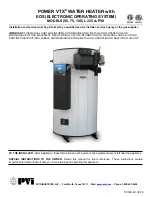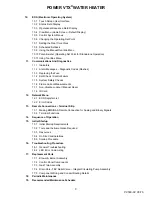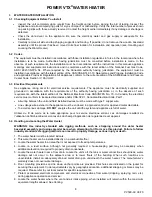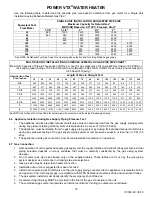
POWER VTX
®
WATER HEATER
9
PV500-68 06/16
3.5 Clearances To Combustible Surfaces
The minimum clearance to combustible material is 16” from the top, 24” from the front and zero clearance (4”) from
the sides and back of the water heater. The POWER VTX
®
can be installed directly on a combustible floor.
Distance minimale aux matériaux combustibles est égale à zéro (10 cm) sur les côtés et à l'arrière, avant les 61 cm,
40 cm de haut et peut être installé directily sur un plancher combustible.
3.6 Service
Clearances
Additional clearance beyond the minimum required to combustible material should be considered to facilitate easy
access for inspection and service of items such as the burner, gas controls and plumbing connections. Also allow
sufficient space for installing and servicing building water, gas, vent, combustion air, electrical, pump and other
auxiliary/optional equipment and connections.
3.7 Other Code and Regulatory Clearances and Requirements
Additional clearance beyond the minimum required to combustible materials and service recommendations may be
required to comply with local, state or national codes and regulations. It is to the responsibility of the installer to
comply with these requirements. Examples of codes or regulations that may apply are the National Electric Code,
State/Regional/National drain water and flue emissions regulations, the National Fuel Gas Code, Building
Construction and Safety Codes, the Americans with Disabilities Act (ADA) and, in states where a water heater above
a certain input or storage capacity is considered a boiler, the applicable boiler code requirements, the applicable
boiler installation requirements in “Safety Code for Controls and Safety Devices for Automatically Fired Boilers”
(CSD-1) and other regulatory requirements.
4
GENERAL PIPING GUIDELINES
4.1 Inlet and Outlet Connections
1. Use only non-ferrous water piping and fittings. When connecting to the POWER VTX
®
tank, there is no
requirement to use di-electric nipples and they are not recommended.Also, do not use galvanized or steel pipe or
fittings.Over time, rust can form inside of steel, galvanized or di-electric pipe, nipples or fittings.
2. Install shut-off valves and unions on the inlet and outlet water piping for servicing. Use caution when threading
pipe nipples into tank connections to prevent cross threading, or over-tightening. Always use a back-up wrench on
tank nipples when tightening unions, valves, etc.
3. Insulate hot water and return circulation lines. Insulate cold water supply lines if subject to freezing during
shutdown periods.
IMPORTANT:
Do not use the plumbing connected to the appliance as a ground for welding or
any other purpose.
4. Pipe the drain valve to a suitable open drain capable of receiving discharge temperatures up to 212ºF.
IMPORTANT
: For maximum efficiency, the inlet water to the POWER VTX
®
should not exceed 100ºF. It is also
recommended that the building return or dishwasher recirculation piping be connected to the return water connection
located at the mid-tank and not to the cold inlet water supply. The POWER VTX
®
utilizes cold inlet water to help
extract almost all of the heat energy from the products of combustion, which lowers the vent temperature to allow the
use of PVC vent pipe. Higher cold inlet water temperatures will reduce heater efficiency and increase the vent
temperature. If the vent temperature approaches the maximum allowed, a vent temperature limit switch will cycle the
heater off to protect the PVC vent.
4.2 Building Return Piping
To maximize water heater efficiency, do not connect the building return or dishwasher recirculation piping (
≈
5 gpm)
directly to the cold inlet. Connect directly to the dedicated building return fitting located at the rear of the tank at mid-
tank level.
























